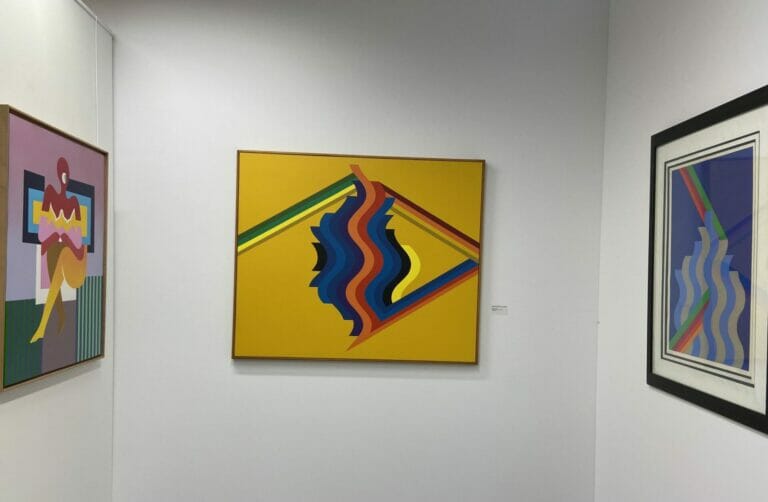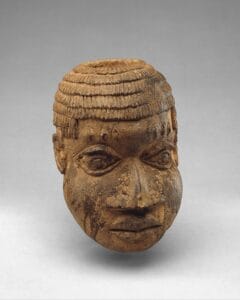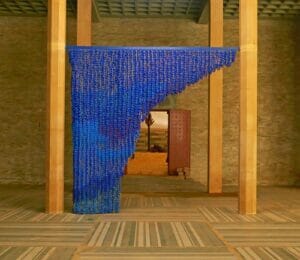In the 1960s, the Casablanca Art School ushered in a golden age of modern art in Morocco. A generation of artists teaching at the school pioneered bold approaches to painting in the post-colonial years following the country’s independence from France in 1956. These trailblazing artists were Farid Belkahia, Mohamed Melehi, Mohammed Chabâa and Mohamed Hamidi, several of which had lived abroad. After soaking up the influence of western modern art, they invented a new artistic language by combining a vision of modernism with Moroccan craftsmanship. In the last few years, their works have been soaring at auction and gaining a greater level of institutional interest.
The market of the Casablanca Art School
Born in 1934, Belkahia was director of Casablanca’s École des Beaux-Arts (Casablanca Art School), from 1962-1974, during which time he hired Melehi, Chabâa and Hamidi to teach there. His tenure heralded in a new artistic era. Indeed, the Centre Pompidou referred to Belkahia as “one of the founders of Moroccan and, more generally, Arabic artistic modernity” when it held a solo show of his work last summer.
Belkahia had studied at the prestigious École Nationale Supérieure des Beaux-Arts in Paris, then moved to Prague where he studied scenography and made expressionist paintings. It was upon his return to Morocco in his late twenties that he became director of the school. Influenced by his education in Europe, he sought to connect artistic modernity with Morocco’s ancestral crafts and traditions. He began making works in copper, a material used in Moroccan crafts. Then after leaving the Casablanca Art School, he experimented further by making works with goat’s hide and organic pigments.
One such piece from Belkahia’s latter period set an auction record for the artist two years ago. His contemplative artwork, ‘Jerusalem’ (circa 1980s), went for £200,000, over double its £70,000-£90,000 estimate, at Sotheby’s in March 2020. Comprising four parts of pigmented animal hide, it appears to be an abstract representation of the Dome of the Rock in the Al-Aqsa mosque compound – one of Islam’s holiest sites – against a blue sky.
The inflation on the avant-garde artists
Melehi – a painter, muralist and photographer – taught at Casablanca Art School from 1964-1969. A highly influential figure, he had studied in Rome, Spain and New York and was inspired by Op Art and the Bauhaus as well as Abstract Expressionism. His signature motif was the wave, his paintings often depicting patterns of waves against a skyline. Indeed, Melehi once said that the wave represented how “the dynamic spirit” of the African continent “rises up forcefully towards the sky”. Believing art to be an integral part of life, he also created murals and co-founded the Asilah Arts Festival in 1978.
In March 2020, Melehi’s painting, ‘The Blacks’ (1963) – a black canvas with blue squares in a horizontal line and yellow vertical stripes at its edges – fetched £399,000 at Sotheby’s, skyrocketing past the estimate of £55,000-£65,000. Melehi made it when he was studying on a scholarship at Columbia University and it bears the influence of Abstract Expressionism.
Several other pieces by Melehi have generated six figures. In November 2020, an untitled painting from 1982 – characterized by crescent moons against blue bands intersected with yellow, green, white and purple waves – sold for £300,000 at Christie’s (Lot 11, estimate £60,000-£80,000). It was auctioned one month after Melehi died of Covid-19.
Like Melehi, Chabâa (1935-2013) had studied in Rome before being hired by Belkahia to teach at the Casablanca Art School. Last year, the exhibition ‘Visual Consciousness’ at Abu Dhabi’s Cultural Foundation traced six decades of his multidisciplinary output ranging from painting and sculpture to murals and graphic design. His vibrant paintings are often characterized by brightly colored geometric shapes and rhythmic lines. For instance, his top-selling painting – ‘Composition’ (1968), a striking red-and-black diptych with interlocking, geometric pink-and-yellow shapes – fetched 4.9m Moroccan Dirhams (US $499,831) at CMOOA auction house in Casablanca in 2016.
Born in 1941, Hamidi is also known for exuberant paintings with delineated shapes, often in primary colors and orange. His striking works are imbued with symbolism and myriad references from sexuality to African art and artists such as Jean Arp. His record is ‘Composition’ (1971), which went under the hammer for 570,000 Moroccan Dirhams (US $59,710) at CMOOA in 2018.




